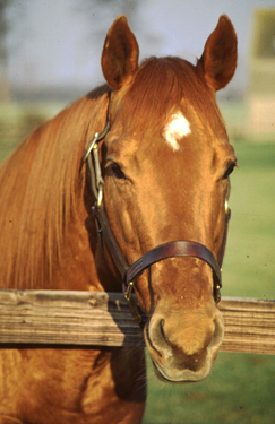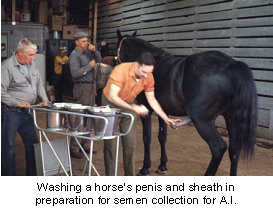How To Clean A Gelding Horses Sheath
Some horse owners feel that it is necessary to 'make clean' a colt or gelding'due south prepuce (sheath) and penis on a fairly regular basis. While this may seem an innocent effort to keep their horse 'clean', sheath washing is usually unnecessary and tin can result in the establishment of quite severe bacterial infection that tin be very difficult to resolve.
What is normal?

The penis and sheath have a permanent population of normal bacteria on their surface, just as all peel surfaces do. These bacteria do non crusade disease; they undoubtedly help maintain the wellness of the pare and may assistance prevent infection by controlling 'unwelcome' leaner. The urethral fossa and sinus, in detail, can harbor potential venereal disease producing bacteria (specifically Klebsiella pneumoniae, Pseudomonas aeruginosa and Taylorella equigenitalis). Infection with these organisms can cause crabs disease in mares following mating but rarely cause signs or symptoms of disease in the carrier stallion, who is usually infected by a carrier mare. When stallions become infected, these organisms may survive on the penile skin alongside of the 'normal' bacterial population and can then exist very difficult to remove.
What harm can sheath cleaning do?
Although sheath washing sounds like a good thought and has been recommended by horsemen universally over the years as an important routine equine direction procedure, it can have a detrimental outcome if the normal 'ecological' balance of skin bacteria is disturbed. Washing the penis and sheath with stiff detergent solutions can remove the natural skin oils, resulting in dry out penile skin that cracks as it folds and unfolds, causing irritation and damage followed by inflammation and secondary infection. If this infection is caused by bacteria that are easy to treat, the problem may resolve spontaneously once washing with detergent has stopped. Local (creams or ointments) or systemic (by injection or by mouth) antibiotic treatment may exist necessary.
Repeated washing with clarified, i.e., antibacterial washes or detergent solutions can event in alteration or removal of the normal penile peel bacterial population. This may result in colonization by unwelcome bacteria that are not normally present, either from the stable environment or following mating with a crabs disease carrier mare, and astringent penile skin and sheath infections can effect. The infection results in inflammation, swelling of local tissues and a profuse foul-smelling discharge that is much more than unpleasant than smegma.
These infections tin be extremely difficult to treat due to the resistant nature of some unwelcome bacteria. In such cases, prolonged treatment with specific systemic and topical antibiotics may exist necessary, followed by a catamenia of remainder and then the application of a specially-prepared 'normal' penile skin bacterial goop culture to re-colonize the surface area. In some cases fifty-fifty this treatment may be unsuccessful and chronic infection may result in thickened croaky penile peel and extreme discomfort.
How should sheath cleaning be performed?

Source: https://vcahospitals.com/know-your-pet/sheath-cleaning-in-horses
Posted by: swainhatratilis1997.blogspot.com


0 Response to "How To Clean A Gelding Horses Sheath"
Post a Comment